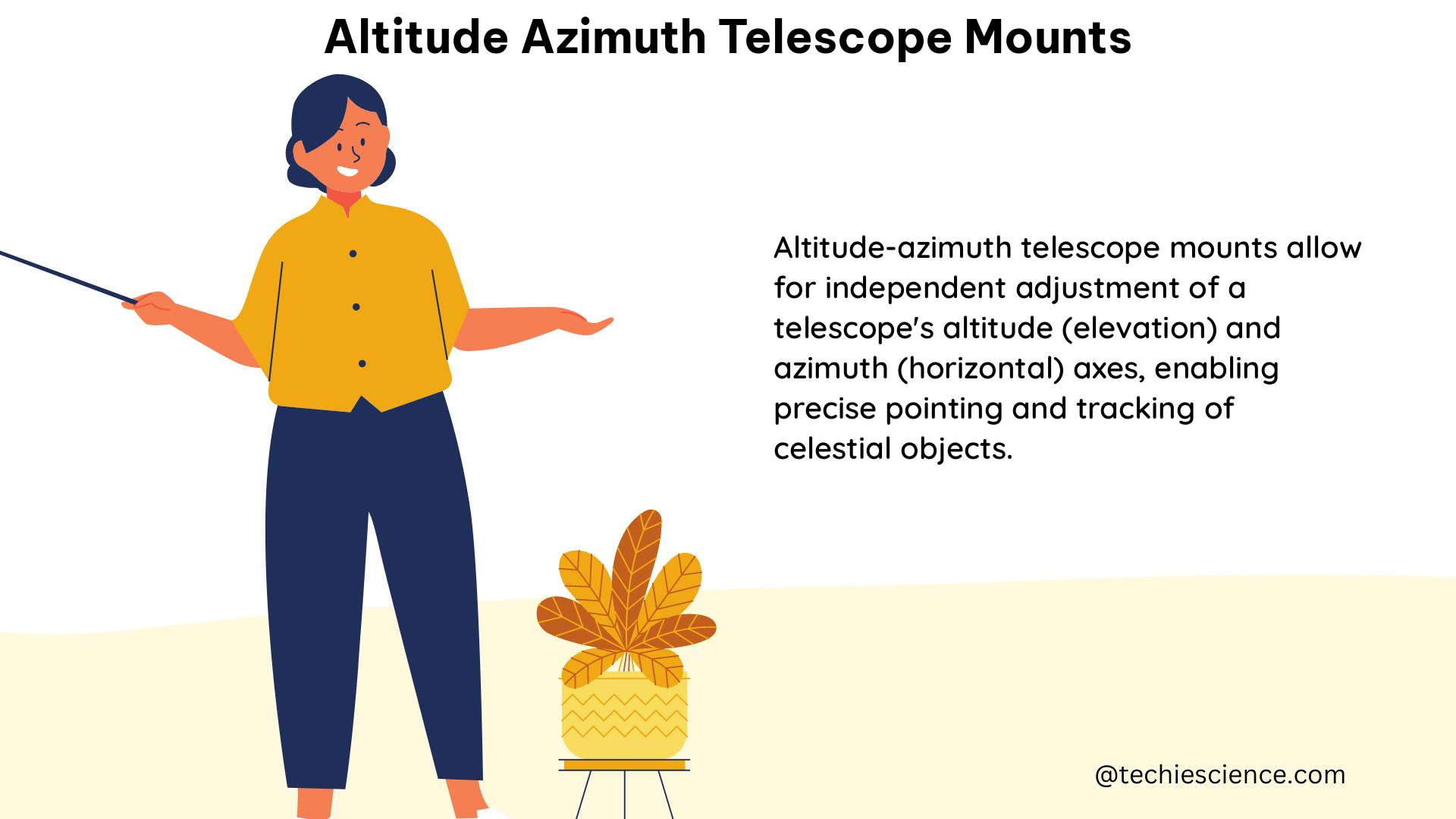Altitude-azimuth (alt-az) telescope mounts are a type of mount used in telescopes that allow for motion in two perpendicular axes: altitude (up-down) and azimuth (left-right). These mounts are simpler in design and easier to construct than equatorial mounts, but they require motion on both axes to accurately track celestial objects as they move across the night sky.
Understanding the Basics of Alt-Az Mounts
Alt-az mounts are designed to move the telescope in two independent directions: altitude (up-down) and azimuth (left-right). This allows the telescope to point at any object in the sky, but it also introduces a unique challenge known as field rotation.
Field Rotation in Alt-Az Mounts
Field rotation is the apparent rotation of the stars in the field of view due to the motion of the telescope in alt-azimuth coordinates. This can cause stars to appear as streaks in long exposure images, rather than points of light. The amount of field rotation depends on the altitude, azimuth, and the observer’s latitude.
The formula for field rotation (deg/hr) is given by:
Field Rotation (deg/hr) = -15 * cos(Altitude) * sin(Azimuth) / cos(Latitude)
This formula allows you to calculate the rate of field rotation based on the current altitude, azimuth, and the observer’s latitude.
Tracking Speed in Alt-Az Mounts
The formula for alt-azimuth tracking speed is based on the hour angle and declination of the celestial object, and the latitude of the observer. The tracking speed in the altitude and azimuth axes can be calculated using the following equations:
Altitude Tracking Speed (deg/s) = 15 * cos(Declination) * sin(Hour Angle) / cos(Latitude)
Azimuth Tracking Speed (deg/s) = 15 * sin(Declination) / cos(Latitude)
These equations allow you to determine the required tracking speed in each axis to accurately follow a celestial object as it moves across the sky.
Limitations of Alt-Az Mounts

Alt-az mounts have a few limitations that are important to understand:
Blind Spot near the Zenith
The alt-az mount has a blind spot near the zenith, which is a limitation on tracking an object through the zenith. This is because as the celestial object approaches the zenith, the azimuth of the object under track changes a finite 180 degrees instead of an infinitesimal amount, which would require infinite rotational speed from the telescope.
Mitigating Field Rotation
One way to mitigate the effects of field rotation is to use a wedge, which aligns the azimuth axis of the alt-az mount with the earth’s axis of rotation, providing motion in right ascension. This allows the alt-az mount to benefit from the features of an equatorial mount, and only needs to be driven in right ascension to track celestial objects.
Measuring Altitude and Azimuth
Measuring the altitude and azimuth of a celestial object can be done using a camera angle app or a specific phone app. However, when comparing these measurements to a program like Stellarium, there might be some discrepancies due to factors such as atmospheric refraction and the specific coordinate system used by the app.
To accurately measure altitude and azimuth, you can use the following steps:
- Align the telescope with a known reference point, such as the North Celestial Pole.
- Use a digital inclinometer or a smartphone app to measure the altitude angle.
- Use a digital compass or a smartphone app to measure the azimuth angle.
- Compare the measured values with the coordinates provided by a planetarium software like Stellarium.
- Adjust the telescope’s position as needed to align with the desired celestial object.
Practical Considerations for Alt-Az Mounts
When using an alt-az mount for astrophotography, it’s important to consider the following factors:
- Field Rotation: As mentioned earlier, field rotation can cause stars to appear as streaks in long exposure images. Using a wedge or other techniques to mitigate field rotation is crucial for high-quality astrophotography.
- Tracking Accuracy: The tracking speed equations provided earlier can help you determine the required tracking speed in each axis to accurately follow a celestial object. Ensuring precise tracking is essential for long-exposure astrophotography.
- Blind Spot near Zenith: When observing or imaging objects near the zenith, be aware of the blind spot in the alt-az mount and plan your observations accordingly.
- Coordinate System Discrepancies: When comparing your measured altitude and azimuth values with a program like Stellarium, be mindful of potential discrepancies due to factors such as atmospheric refraction and the specific coordinate system used by the app.
By understanding the technical details and practical considerations of alt-az telescope mounts, physics students can effectively use these mounts for a wide range of astronomical observations and astrophotography projects.
References
- Field Rotation and Alt-Azimuth Mounted Telescopes – Kelly Flanagan
- Alt-azimuth tracking speed formula? – Stargazers Lounge
- Why does the altitude-azimuth mount have a blind spot near zenith?
- Measuring Altitude and Azimuth – Cloudy Nights
- An Analysis of Field Rotation Associated with Altitude-Azimuth Mounted Telescopes
- Alt-Azimuth Mount – Wikipedia
- Field Rotation – Wikipedia
- Alt-Azimuth Tracking – Wikipedia
- Alt-Azimuth vs Equatorial Mounts – Sky-Watcher
- Alt-Azimuth Mounts – Celestron

The lambdageeks.com Core SME Team is a group of experienced subject matter experts from diverse scientific and technical fields including Physics, Chemistry, Technology,Electronics & Electrical Engineering, Automotive, Mechanical Engineering. Our team collaborates to create high-quality, well-researched articles on a wide range of science and technology topics for the lambdageeks.com website.
All Our Senior SME are having more than 7 Years of experience in the respective fields . They are either Working Industry Professionals or assocaited With different Universities. Refer Our Authors Page to get to know About our Core SMEs.